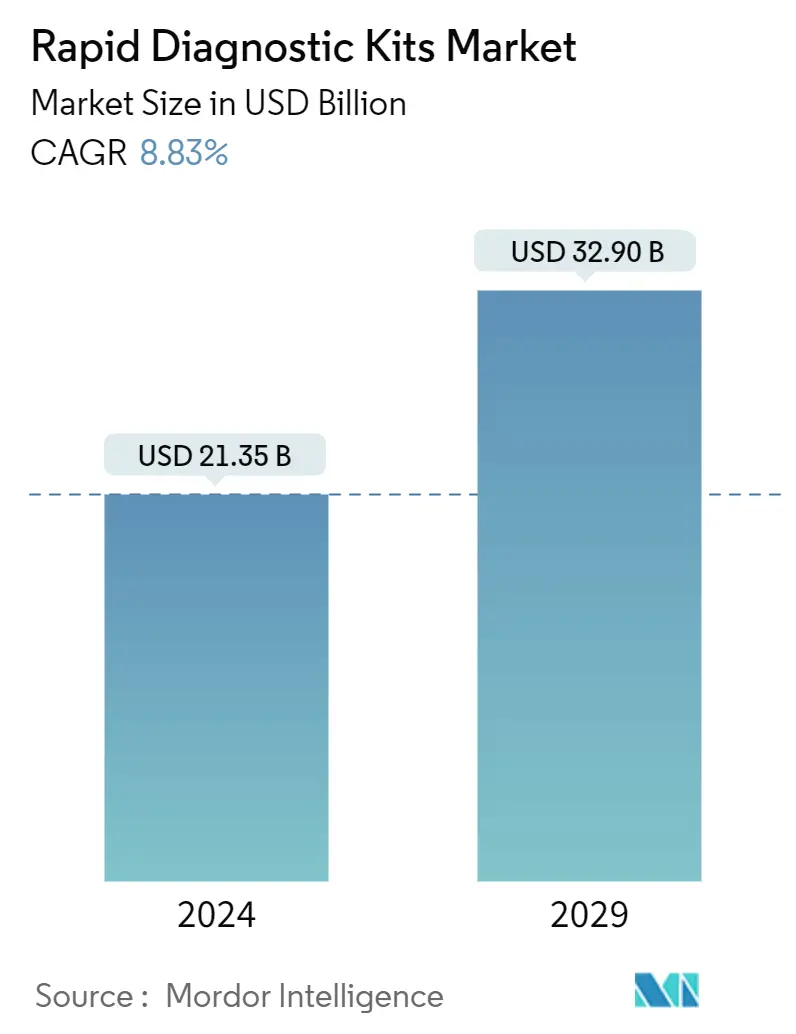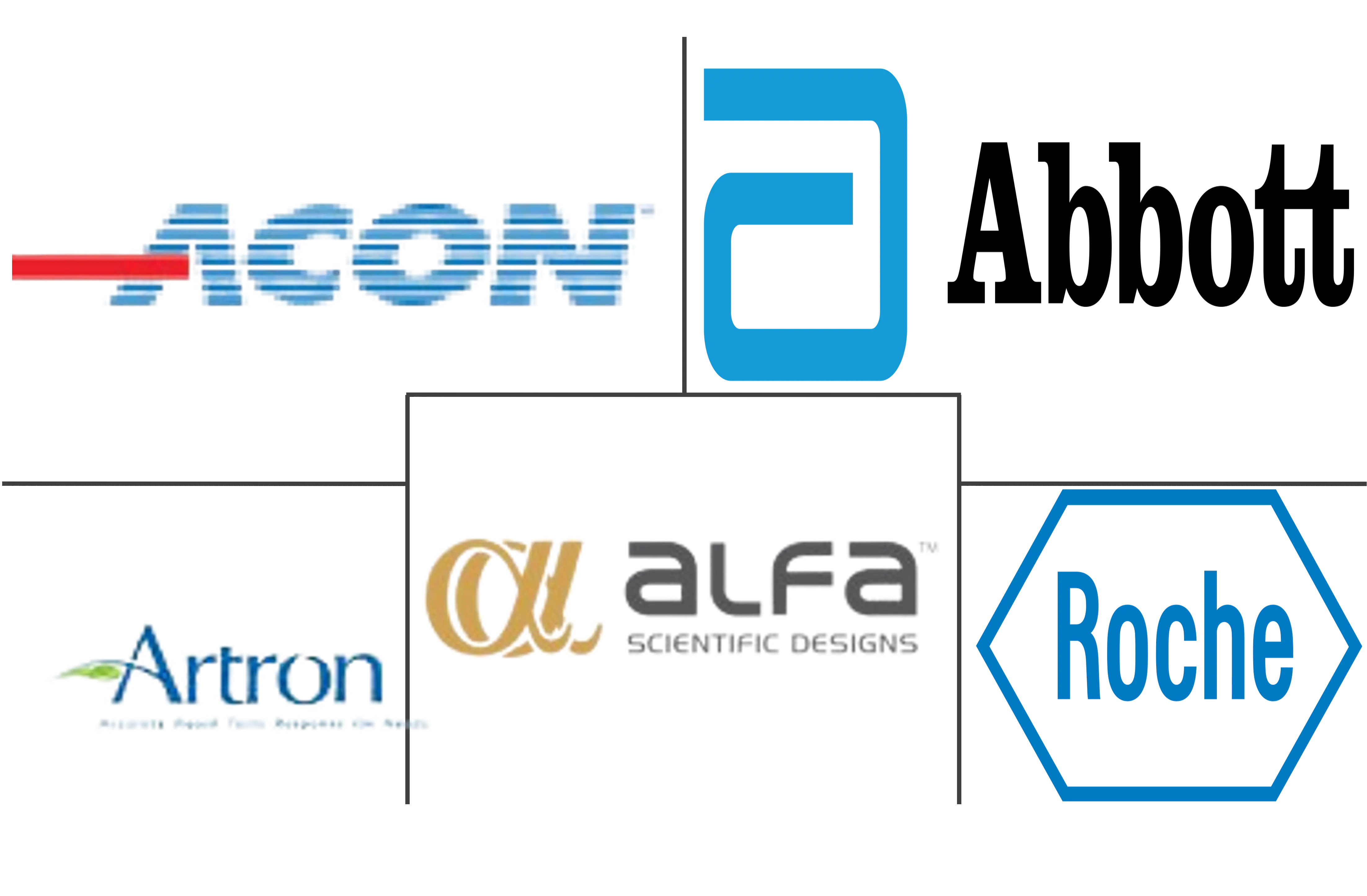Market Size of Rapid Diagnostic Kits Industry

| Study Period | 2021 - 2029 |
| Market Size (2024) | USD 21.35 Billion |
| Market Size (2029) | USD 32.90 Billion |
| CAGR (2024 - 2029) | 8.83 % |
| Fastest Growing Market | Asia Pacific |
| Largest Market | North America |
Major Players
*Disclaimer: Major Players sorted in no particular order |
Need a report that reflects how COVID-19 has impacted this market and its growth?
Rapid Diagnostic Kits Market Analysis
The Rapid Diagnostic Kits Market size is estimated at USD 21.35 billion in 2024, and is expected to reach USD 32.90 billion by 2029, growing at a CAGR of 8.83% during the forecast period (2024-2029).
The COVID-19 pandemic positively impacted the rapid diagnostics market in terms of revenue; however, the pandemic negatively impacted the sales of routine testing kits used for non-COVID-19 diseases and lockdowns. For instance, in April 2021, the Federal Government of Germany made it mandatory for employers in Germany to offer free COVID-19 self-testing kits to employees not working from home once a week. Further, in March 2021, The German Federal Ministry of Health approved the sale of COVID-19 rapid antigen tests in supermarket chains, drug stores, pharmacies, and e-commerce websites. Additionally, in March 2021, Becker's Healthcare published that the United States government launched a national testing strategy to control the spread of COVID-19. Through this testing strategy, the Government opened four COVID-19 testing hubs nationwide with an investment of USD 650 million.
Moreover, the launches of several COVID-19 diagnostics kits and government investments in COVID-19 research further boosted the market growth during the pandemic. However, in the post-pandemic period, the number of COVID-19 infections decreased, and the research, diagnosis, and treatment of other infectious and chronic diseases resumed, leading to the market's growth. Thus, COVID-19 boosted the growth of the market initially. However, the market is growing normally with the decrease in the COVID-19 infection and the resumption of rapid diagnosis of other infectious and chronic diseases.
Furthermore, the rapid diagnostic kits market is expected to grow during the forecast period with the increasing government initiatives for diagnosing infectious diseases, rising awareness regarding early diagnosis among people, and shifts in technological and commercial environments.
In the past few years, infection tracking and surveillance programs have increased to track the infection rate of certain pathogens. These programs utilize rapid diagnostic assays to detect and confirm infections. Thus, with such programs, the demand for rapid diagnostic assays is expected to increase, likely to drive market growth. The Early and timely identification of infectious diseases propels disease surveillance programs and is important for vector control measures. Due to their easy accessibility and quick turnaround time for results, rapid test kits are increasingly being utilized to track recent emerging infections. For instance, in February 2021, the Centers for Disease Control and Prevention (CDC) reported 7,860 cases of Tuberculosis in the United States (a rate of 2.4 per 100,000 persons).
Further, in May 2021, according to the data published by the TB Facts Org 2021, over 10.6 million were estimated to be affected with Tuberculosis (TB) in the year 2021, which showed an increase of 4.5% compared to the previous year. Furthermore, while microscopy and culture remain essential for tuberculosis laboratory diagnosis, the spectrum of rapid diagnostic test kits, particularly the Nucleic Acid Amplification Test (NAAT), has greatly expanded. For instance, The World Health Organization (WHO) in 2021 recommended the use of molecular NAATs for Tuberculosis detection instead of smear microscopy since they detect Tuberculosis more correctly, especially in patients with paucibacillary illness and persons living with Human immunovirus (HIV). They are becoming more widely available for detecting and identifying mycobacterium tuberculosis complex in clinical specimens and for diagnosing multi-drug resistant strains. Further, in March 2022, Brain Chemistry Labs, a non-profit research institute, and Arlington Scientific, a Utah-based medical test kit manufacturer, announced the development of an easy-to-use rapid test kit. This kit will detect the presence of β-methylamino-L-Alanine (BMAA), a toxin in cyanobacterial blooms, which causes a fatal paralytic disease called Amyotrophic Lateral Sclerosis (ALS). Thus, with such developments, the penetration of rapid diagnostic assays is expected to increase further, driving the market's growth in the coming years.
Additionally, the increasing government initiatives for diagnosing and researching infectious diseases are boosting the growth of the studied market. For instance, in September 2021, the Government of New Zealand invested over USD 22.47 million (NZD 36 million) in a new Infectious Diseases Research Platform to support Aotearoa New Zealand's Covid-19 response and preparedness for future pandemics. Further, in September 2022, the Government of Australia invested over USD 179.02 million (AUD 266 million) for three years into the seventh replenishment of the global fund to control acquired immunodeficiency syndrome (AIDS), malaria, and Tuberculosis.
Therefore, owing to the factors above, including the increasing prevalence of infectious diseases, increasing government investment in research, and the key developments by the market players, the studied market is anticipated to witness growth over the analysis period. However, the lack of awareness regarding newer rapid diagnostic tests and failure to eliminate the need for microscopy diagnosis will likely impede market growth.
